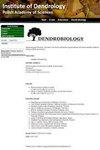分子系统发育分析解决土耳其自然发现的柳属物种分类差异
IF 1.8
4区 农林科学
Q2 FORESTRY
引用次数: 1
摘要
本文利用叶绿体DNA区(trn T-F、matK和rbcL)对在土耳其自然发现的26个柳属的分类地位和系统发育进行了研究,揭示了它们之间的关系。利用土耳其自然发现的26个柳属分类群(24个种)的158个基因序列和126个新生成序列,构建了柳属的系统发育树。对叶绿体(cpDNA)和细胞核(nrDNA) DNA区域的序列数据进行系统进化分析,在亚属水平(Salix和Vetrix)上进行了可靠的属分类,后验概率/ bootstrap值为1/100。这一研究结果为五雄树属(S. pentandroides)、阿波达树属(S.apoda)、亚美尼亚树属(S. armenorossica)、伪半叶树属(S. pseudomedemii)和带蒂树属(S. pedicellata subsp)的柳系进化位置和分化时间提供了重要信息。马先蒿、假花马先蒿、大花马先蒿、三棱马先蒿2个亚种和土耳其特有种2个(紫花马先蒿亚种)。leucodermis和S. rizeensis)首次发现。在分类学上,以往归为黄柳亚属的大黄柳和黄柳在系统发育上归为柳亚属。亚属柳属似乎是从亚属发散出来的。始新世(约45.1万年)的Vetrix;柳属和亚属。Vetrix的年代分别为23.1万年和21.65万年。然而,土耳其柳属(Salix)和柳属(Vetrix)亚属的物种分化时间似乎在上新世左右。土耳其柳与世界柳的分子系统发育关系主要表现为分类等级关系,而非地理亲缘关系。本文章由计算机程序翻译,如有差异,请以英文原文为准。
Molecular phylogenetic analysis resolving the taxonomic discrepancies among Salix L. species naturally found in Turkey
Detailed phylogenetic relationships and molecular dating are still quite rare for the complex and diverse genus Salix L. Here we focus on the taxonomic status and phylogeny of twenty-six Salix taxa naturally found in Turkey using the chloroplast DNA regions (trn T-F, matK, and rbcL) to unravel the relationship among them. The status of Salix species was also checked in the phylogenetic tree constructed with the data from Internal Transcribed Spacer (ITS) region of nuclear gene, including 158 accessions from the GenBank and 126 newly generated sequences of 26 Salix taxa (24 species) naturally found in Turkey. The phylogenetic analysis of the sequence data from both the chloroplast (cpDNA) and nuclear (nrDNA) DNA regions enabled a reliable classification of the genus at the subgeneric level (Salix and Vetrix) with high posterior probability/ bootstrap values as 1/100. The study provides important information on the Salix phylogenetic placements and diverging times of S. pentandroides, S.apoda, S. armenorossica, S. pseudomedemii, S. pedicellata subsp. pedicellata, S. pseudodepressa, S. amplexicaulis, two subspecies of S.triandra, and two endemic species of Turkey (S. purpurea subsp. leucodermis and S. rizeensis) for the first time. Taxonomically, S. amplexicaulis and S. rizeensis previously classified under the subgenus Vetrix were clustered phylogenetically under the subgenus Salix. Subgenera Salix species appears to be diverged from the subg. Vetrix in Eocene (ca. 45.1 Mya) while the estimated divergence times of subg. Salix and subg. Vetrix dated back to 23.1 and 21.65 Mya, respectively. However, divergence times among species within Salix and Vetrix subgenera of Turkey seem to be around the Pliocene period. Molecular phylogenetic relationship between Salix species native to Turkey and Salix species from the world were mainly associated with taxonomic hierarchy, rather than geographic proximity.
求助全文
通过发布文献求助,成功后即可免费获取论文全文。
去求助
来源期刊

Dendrobiology
农林科学-林学
CiteScore
2.20
自引率
11.10%
发文量
17
审稿时长
>12 weeks
期刊介绍:
Dendrobiology publishes original research articles and review articles related to the biology of trees and shrubs.
 求助内容:
求助内容: 应助结果提醒方式:
应助结果提醒方式:


